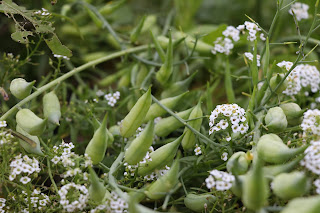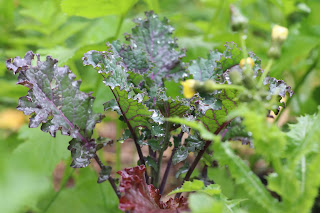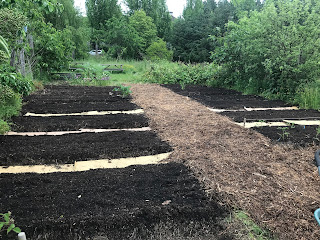The small-scale and organic cultivation of Traditional Chinese Medicine (TCM) herbs is a new project started this
year at the UBC Orchard Garden. Two garden beds of TCM herbs were planted in early July by a small group of volunteers from the UBC Orchard Garden Community. The plants
are currently growing beneath the canopy of a plum tree in
the Food Forest.
What is Traditional Chinese Medicine, and Why Grow Medicinal Plants?
Traditional
Chinese Medicine is a holistic system of medical theory, wellness
practices, and healing modalities originating
from China, and is estimated to be over 3000 years old (Schafer, 2011).
Like other ancient traditional medicines, such as Ayurveda, TCM has an
extensive herbal focus. This can be seen in the highly influential Ming Dynasty text Bencao
gangmu,
or Compendium of Materia Medica, written by Li Shizhen contains
descriptions of 1094 herbs, 444 animal parts, and 275 mineral substances
(Britannica, 1998). Both the theory and practice of
TCM draw heavily from the naturalistic Daoist philosophy, which
emphasizes holism, interrelationship, harmony, and balance, and situates
health and illness within the unbroken context of the individual’s
physical, psychological, and emotional well-being (Kaptchuck,
1983). Treatment within TCM is therefore individualistic, holistic, and emphasizes relationality
between doctor and patient, and between patient
and their life-world. For example, TCM herbal formulas are commonly
individually tailored to the specific condition of each patient.
Over
the last ten years, acupuncture and TCM herbalism have become
increasingly popular in Vancouver, with people
looking for alternative holistic treatment outside Western medicine. TCM
clinics can now easily be found on every major street in Vancouver.
However, most of the TCM herbs
used by TCM practitioners in North America, and sold in local
pharmacies, are still sourced from Asia. Longtime Chinese medicinal
herb-grower Peg Schafer points out three concerns for continuing
reliance on current sourcing practices for Asian medicinal herbs:
unsustainable collecting practices because the majority of herbs in China are
still harvested from the wild, concerns over quality, and the rising
costs of herbs (Schafer, 2011). Over the last 20 years, these reasons
have led her, and other growers around the United
States such as Joe Hollis and Jean Giblette, to start cultivating
Chinese medicinal plants locally in order to ensure greater
accessibility and high quality.
The TCM garden, much like the UBC Orchard Garden, is intended as a demonstration
and learning garden. Emphasis is placed on promoting
both the cultural
and medicinal aspects of Traditional Chinese Medicine, as well as local
cultivation of TCM herbs. If you are interested in visiting the TCM
garden, or learning more about Traditional Chinese Medicinal herbalism,
growing medicinal herbs and other related activities,
please sign-up for our newsletter to keep informed about volunteer opportunities and upcoming workshops.




































